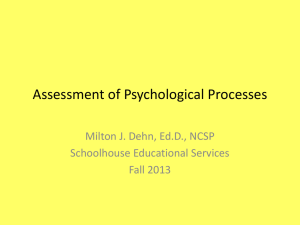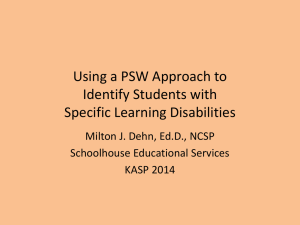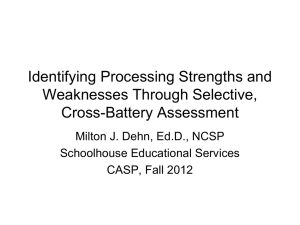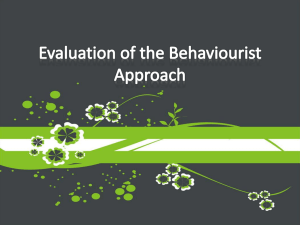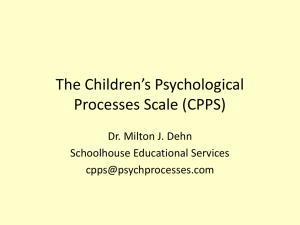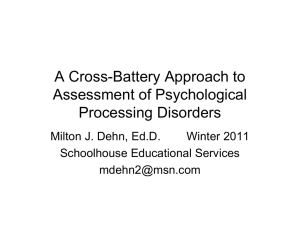Milton Dehn 1 - Ala-CASE
advertisement
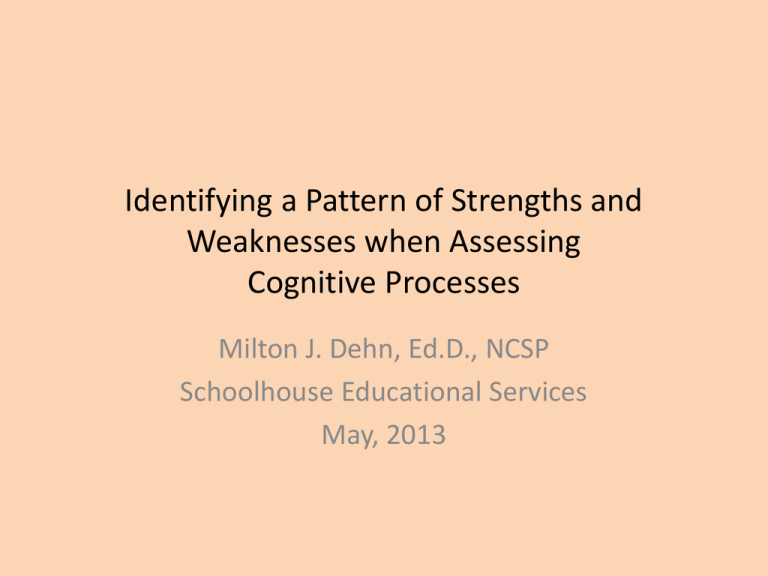
Identifying a Pattern of Strengths and Weaknesses when Assessing Cognitive Processes Milton J. Dehn, Ed.D., NCSP Schoolhouse Educational Services May, 2013 Notice of Copyright 2013 This PowerPoint presentation and accompanying materials are copyrighted by Schoolhouse Educational Services, LLC and Milton J. Dehn. They are not to be reprinted, copied, or electronically disseminated without written permission. To obtain permission, email milt@psychprocesses.com Workshop Information Sources • • • • • Essentials of Processing Assessment, 2nd Ed. Children’s Psychological Processes Scale Bibliography in handout Other cited references www.psychprocesses.com Workshop Topics 1. 2. 3. 4. 5. 6. Processes to assess Processes and academic skills Neuroanatomy of processes Selective, cross-battery testing Identifying strengths and weaknesses SLD identification using a pattern of strengths and weaknesses 7. Overview of processing interventions What are Psychological Processes? 1. 2. 3. 4. 5. 6. 7. 8. Includes “cognitive” processes Brain processes, operations, functions Any time mental contents are operated on When information is perceived, transformed, manipulated, stored, retrieved, expressed Whenever we think, reason, problem-solve Basic and higher level processes Doesn’t include knowledge or academic skills Learning depends on these processes; they underlie academic skills The Need for Processing Assessment 1. Part of a neuropsychological approach 2. Not just for SLD but Autism, ADHD, TBI, etc. 3. Neuroscience has increased understanding of brain-learning relationships 4. A deficit in a “psychological process” is part of federal and states’ SLD definitions 5. Identification leads to more appropriate interventions Federal & State SLD Criteria 1. SLD is…… “a disorder in one or more of the basic psychological processes” 2. IDEIA 2004 allows alternative research-based procedures (the third method) 3. Been interpreted as allowing use of a pattern of strengths and weaknesses (PSW) in SLD diagnosis 1. In achievement, cognitive abilities, or psychological processes Processing Assessment Advantages 1. Benefits the learner: better understanding 2. Identifying a processing deficit differentiates SLD & slow learning 3. Identifying processing deficits provides direction for academic interventions Processing and RTI 1. Processing model consistent with problemsolving and early intervention 2. There are evidence-based processing interventions 3. Different processing “causes” of SLD 4. Why do “blind” academic interventions 5. Processing & academic interventions compatible---why they work Characteristics of Psychological Processes to Assess 1. 2. 3. 4. 5. Brain-based Interrelated Necessary for academic learning Both broad and narrow processes Manifestations of processing problems are observable in classroom Processes for SLD Assessment 1. Attention 2. Auditory Processing 3. Executive Functions 4. Fine Motor 5. Fluid Reasoning 6. Long-Term Recall 7. Oral Language 8. Phonological Processing 9. Processing Speed 10. Visual-Spatial Processing 11. Working Memory (WM) Human Processing Limitations 1. Human limitations 2. Which processes does the chimp excel at? Attention 1. Necessary for learning and memory 2. Attention deficits part of LD 3. Not necessarily ADHD 1. 2. ADHD is more hyperactive/impulsive Inattentive type is more cognitive/learning problems 4. Types: Selective, focused, divided, sustained 5. Problem: attentional control & inhibition 6. Related to Executive Functions and Working Memory Auditory Processing 1. Ability to perceive, analyze, synthesize, and discriminate auditory stimuli, mainly speech 2. Perceiving and comprehending instruction; being able to understand words with background noise Executive Functions 1. Management of cognitive functions and psychological processes 2. Effectiveness depends on selfmonitoring, self-regulation, and metacognition 3. Has a longer course of development 4. More to do with classroom performance than learning of academic skills Fluid Reasoning 1. Deductive, inductive reasoning, especially with novel materials 2. Has a longer course of development 3. More important for applied academics Long-Term Recall 1. Close connection with other processes and with academic learning in general 2. Includes encoding, consolidation, storage, and retrieval 3. Rapid automatic naming is part of Oral Language 1. Not the content (vocabulary) or receptive language but the oral expression processes Phonological Processing 1. Processing of phonemes, e.g. blending 2. Phonemic awareness is part of Processing Speed 1. How quickly information flows through the processing system; a matter of efficiency 2. Too slow: info. lost, process not completed Visual-Spatial Processing 1. The ability to perceive, analyze, synthesize, manipulate and think with visual patterns 2. A strength in most LD cases 3. Weak relations with all academics; more of a “threshold” process Working Memory 1. 2. 3. 4. Processing while retaining information Includes short-term memory Both verbal and visual An executive component Processes and Academic Learning 1. Psychological processes are like “aptitudes” 2. Relations established through research 1. Flanagan et al., & McGrew 2. Swanson, Geary, and others 3. The influence of processes varies by age 4. For SLD look for academic area and related psychological processes to both be low 5. See Table Research: SLD by Processing Subtypes 1. Visual-Spatial Deficits: Math calculation and math problem solving 2. Processing Speed Deficits: Reading comprehension, written expression 3. Working Memory Deficit: Math calculation, Written expression 4. Attention: Written expression Source: Hain, Hale, Kendorski Dehn’s Processing Theory “For each academic skill there is an optimal set of psychological processes that function as aptitudes. For successful learning of a specific academic skill, the combined set of specific aptitudes must attain a sufficient threshold of development.” Link Processing Clusters: Memory Example • • • • • • • Attention Executive Functions Fluid Reasoning Long-Term Recall Processing Speed Working Memory See Link for other clusters Developmental Groupings Mature early after gradual development: • Auditory Processing • Fine Motor Processing • Long-Term Recall • Phonological Processing • Visual-Spatial Processing • See link for other groupings Neuroanatomy of Processes Neuroanatomy of Processes 1. 2. 3. 4. Most in more than one brain lobe Illustrates the interconnectivity of processes Most have specific structures within a lobe Processing speed is a function of interconnectivity; does not have a specific structure Occipital Lobe 1. Dedicated to vision and visual-spatial processing 2. Receives sensory data from the thalamus 3. Visual and spatial processing are separate 4. Dorsal stream (upper) sends spatial information to parietal lobe 5. Ventral stream (lower) sends visual information to temporal lobe Temporal Lobe 1. Auditory processing 2. Long-term memory processing in the hippocampus 3. Some visual processing 4. Semantic memory storage Parietal Lobe 1. Integrates sensory information 2. Language processing 3. Phonological processing Frontal Lobe 1. 2. 3. 4. 5. 6. 7. 8. The “output” lobe; others are input Executive functions---prefrontal cortex Working memory---prefrontal cortex Attentional control---prefrontal cortex Fluid reasoning Fine motor Oral expression No storage of long-term memories Processing Assessment Challenges 1. 2. 3. 4. 5. Connecting to academic concerns Interrelated processes Not all are found in one convenient battery Doing it efficiently Linking with interventions Processing Assessment Principles 1. Should be multimethod, multisource, and multisetting 2. Informal, qualitative not enough 3. Should include standardized testing 4. Should be hypothesis driven 5. Selective, cross-battery testing 6. Integrate data during interpretation Records Review 1. 2. 3. 4. Any medical or health conditions Age of onset Developmental delays Look for reported behaviors that indicate processing problems 1. Difficulty memorizing arithmetic facts: WM 2. Difficulty blending: Phonological processing 3. Low fluency: Processing speed Interviews 1. Ask directly about processes but also ask about behaviors that are manifestations of processing weaknesses 2. Teachers: Ask about their hypotheses 3. Parents: Home environment examples 4. Students: Middle school and older 5. Suggested teacher and parent interview items will be in revised book Observations 1. An observed behavior is due to more than one process 2. Look for several problematic behaviors that go with a specific process 3. See link Dehn’s Approach to Cross Battery 1. Not limited to CHC factors 2. “Narrow” abilities/processes included 3. Includes processing factors that are important for learning of academic skills 4. Includes rating scales 5. Subtests classified through task analysis 6. Analyze scores at the composite (twosubtest) level whenever possible Cross-Battery Testing 1. Assessment driven by hypotheses 2. Mix scales/batteries to cover all the areas 1. Try to limit the number of scales 2. Should be normed about the same time 3. Avoid redundancies when testing 4. Ideally, 2 subtests per process 5. Analyze results together and use a crossbattery mean to determine discrepancies Selective Testing 1. Test all processes important for academics With most attention to an in-depth assessment of hypothesized weaknesses 2. Apply a cross-battery approach 3. Pick composites first 4. Categorized by factor and task analysis 5. See selective testing tables Link 6. See comprehensive list link from book Hypothesis Testing Approach 1. Given academic deficiency, what are the most likely process deficits 2. It’s “why” the child has a learning problem 3. Include non-processes 4. Must collect assessment data to “test” hypotheses 5. Try to avoid “confirmatory bias” 6. We all have weaknesses Planning a Processing Assessment 1. 2. 3. 4. Complete the processing assessment planner Template Completed example See case study Six-Year Old Case Study Concerns 1. 2. 3. 4. 5. 6. 7. 8. Learning colors, letters, and numbers Inconsistent performance Recognizing and generating rhyming words Reading learning difficulties Doesn’t remember directions Difficulty getting started on a task Word retrieval problems Math learning difficulties Processing Analysis Worksheet 1. 2. 3. 4. 5. 6. 7. 8. Composite scores from test manual when possible Convert all scores to standard scores Exclude non-processing factors and subtests Compute clinical process scores by averaging Compute processing mean Calculate discrepancies Determine weaknesses and deficits Do pairwise comparisons Completed Example 1. Opposites and those closely related 9. Complete worksheet and interpret Using Dehn’s Processing Analysis Worksheet to Determine PSW 1. Deficit = both normative and intra-individual weakness (deficit is a “strong” weakness) 2. Scores below 90 are normative weaknesses 1. Below 85 if not using deficit approach 3. Intra-individual strengths and weaknesses use 12 point discrepancy 1. Assumes composites/subtests have hi reliability 2. Use 15 points if not using deficit approach 4. Automated worksheet PSW Principles Regarding SLD 1. 2. 3. 4. 5. 6. 7. 8. Neurologically-based deficits underlie SLD There’s no SLD if there’s no processing deficit Some processes highly related with academic skills Processing deficits related to academic deficits SLD have average or near average cognitive ability Weakness should be normative &intra-individual Weakness: statistically significant and unusual PSW doesn’t mean there is a learning disability. Concordance-Discordance Model 1. From James Brad Hale Link 2. Similar to Naglieri’s model 3. Processing areas not significantly related to the academic area should be discordant: Processing strengths should be significantly higher than the academic weakness CHC Model 1. A process related to the academic deficiency is weak or deficient 2. Unexpected underachievement: Process and academic deficit exist with otherwise normal ability 3. Regarding strengths, at least some processes should be in the average range Dehn’s PSW Model 1. 2. 3. 4. 5. 6. 7. Normative weakness + intra-individual weakness = deficit At least one process is a deficit Intra-individual weakness is statistically significant Subtest scores must be unitary for a deficit At least one processes is in average range (strength) The deficit is related to deficient academic skill Consistency between process score(s) and the related academic skill score Link Determining Weaknesses & Deficits 1. Intra-individual strengths and weaknesses 1. Should be at least a 12-point discrepancy 2. 15 points if not using deficit rule 2. Normative weakness when score below 90 3. Deficits are rare statistically, have a neurological basis, and impair learning 4. Most states require only a weakness (typically an intra-individual weakness) but not a deficit, and also require strengths Support for Strengths and Weaknesses 1. Informal data supports test scores and results of score analysis 2. Corroboration especially needed when scores differences are less than one standard deviation (12-14 points) 3. Integrate and label data when writing report 4. Weaknesses match with specific academic areas they are highly related with Psychological Processing Analyzer 1. Available at www.psychprocesses.com 2. Identifies strengths, weaknesses, deficits 3. Conducts cross-battery analysis using composites and/or subtest standard scores 4. 11 psychological processes 5. From 22+ different scales: cognitive, achieve., rating, and processing link Psychological Processing Analyzer 1. Composite and subtests are limited to those that are fairly direct measures 2. Some are re-classified based on the primary demands of the task 3. Difference formulas based on reliability coefficients of composites/subtests 4. Regression toward the mean 5. .01 or .05 level of significance Psychological Processing Analyzer 1. All scores converted to standard scores 2. Non-unitary process scores are flagged 3. Predicted score for each process based on mean of other 10 4. Differences greater than critical values are intra-individual weaknesses 5. Deficits are both types of weaknesses 6. Pairwise comparisons are optional Link Other Options for Determining PSW 1. Cross-battery software based on CHC taxonomy 1. Only shows one process weakness at a time 2. Use simple difference (SED) formula 1. Uses reliability coefficients 3. Advanced formula can be used when correlation between measures is known 4. Checking for confidence interval overlap Rating Scales 1. Processing deficits are manifested through behaviors 2. Behavior ratings can be used to measure processing abilities 3. Examples: BRIEF and other Executive Function Scales 4. Also, the new CPPS Children’s Psychological Processes Scale (CPPS) Overview 1. 2. 3. 4. 5. 6. 7. Standardized teacher rating scale Ages 5-0-0 to 12-11-30 121 items across 11 subscales Entirely online, internet-web based Online administration time of 15 minutes Online scoring and report Author: Milton Dehn; published by Schoolhouse Educational Services, 2012 8. Measurement Consultant: Kevin McGrew The Purposes of the CPPS 1. SLD Evaluations 1. Identify psych processing deficits 2. Pattern of strengths and weaknesses 3. Data for SLD diagnosis 2. Screening 1. Identifies need for intervention 2. Predicts academic skills development 3. Useful in planning comprehensive assessment 3. Planning interventions 4. Measure progress during interventions 1. Through the use of change-sensitive W-scores CPPS Standardization 1. 2. 3. 4. 5. 6. 7. 1,121 students rated by 278 teachers 128 communities in 30 states All data collected online Demographics match U.S. Census well Norms: 4 age groups (5-6; 7-8; 9-10; 11-12) Included children with disabilities Demographics details Link How The Online CPPS Works 1. A psychologist’s side and a teacher’s side 2. Psychologist fills in teacher information and email sent 3. Teacher: student info and completes ratings 4. Psych receives email stating ratings complete 5. Psych generates report 6. See screen shots CPPS Administration 1. Online rating scale 12-15 minutes for teachers to complete 1. Can print free paper copy and enter later 2. Must answer all items (but can save incomplete) 2. Never, Sometimes, Often, Almost Always 3. Rating scale saved until report generated CPPS Items • Grouped by subscale • In developmental (ability) order from lowest item to highest item • Link • Example of scoring in developmental sequence Link CPPS Report 1. 2. 3. 4. Brief narrative, graph, and a table of scores Change-sensitive W-scores T-scores; percentiles; confidence intervals Intra-individual strengths and weakness discrepancy table 5. T-score to standard score converter 6. Can be re-run with different options (without extra charge) Example Discrepancy Analysis 1. Use discrepancy table to determine pattern of strengths and weaknesses (reversed) 1. 2. 3. 4. Predicted score based on mean of other 10 Regression toward the mean included +/- 1.00 to 2.00 SD of SEE discrepancy options Strengths and Weakness labeling is opposite of discrepancy, e.g. “-” value = a strength 5. Non LD also have a pattern Link T-Score Conversion Table 1. Optional 2. Purpose: To see how consistent CPPS scores are with achievement and cognitive scores 3. T-score x 1.5 + 25 and then reverse distance from mean 4. Example: T-score of 60 x 1.5 = 90 + 25 = 115 5. Then subtract 15 from 100 = 85 Example CPPS General Processing Ability (GPA) 1. Based on average of all process scores 2. Emerges from factor analysis; similar to concept of general intelligence 3. Processes function in an inter-related fashion 4. Most processes contribute to any given behavior, task 5. On CPPS defined as “the underlying efficiency of processing” Diagnostic Accuracy for LD 1. 37 LD subjects with broad demographics 2. Compared to matched controls, LD subjects had significantly higher means on all subscales Link 3. The CPPS had high classification accuracy in regards to LD 1. Using CPPS GPA cutoff of 60 had a 92% classification accuracy across 74 subjects Diagnosing LD with the CPPS 1. Look for pattern of strengths and weaknesses (discrepancy table) 2. Weaknesses should also be normative weaknesses (T-scores above 60) 3. Weaknesses should link to evidence-based achievement relations 4. Same criteria as PSW model Discussion 1. How will you do processing assessment differently? 2. How will you determine weaknesses, strengths, deficits? Using Assessment Results to Plan an Intervention 1. Select deficits and intra-individual weaknesses for intervention 2. Consider related processing weaknesses 3. Consider executive and WM limitations 4. Individualize Interventions for Processing Weaknesses & Deficits 1. Strengthen weakness if possible 2. And utilize the strong areas more 3. Modifications that reduce the need to use the weak processes 4. Use methods that involve other processes, more of the brain Attention: Self-Monitoring 1. Teacher, or device carried by student, cues student at variable intervals, such as 5 minutes 2. When cued, student marks monitoring sheet regarding behavior when cue occurred: 2Completely on task; 1-Partially on task; 0Completely off task 3. When teacher is cueing, she also provides her rating alongside student’s; student receives bonus point when ratings match 4. Set a points goal that student is working for, easy at first, then keep adjusting upward Link Auditory Processing 1. Same as interventions for CAPD 2. Recoding auditory into visual information 3. Visual representations should accompany verbal presentations 4. Quiet environment 5. Improve acoustics 6. Fast ForWord 7. Auditory trainers (individual sound systems) Executive Function 1. Increase metacognitive awareness 2. Teach planning 3. Work completion: set goal and time Planning 1. Developing planning improves math performance 2. Discuss benefits of plans 3. Develop plans 4. Verbalize them 5. Implement them and evaluate Fine Motor 1. Occupational therapy 2. Handwriting practice Fluid Reasoning 1. 2. 3. 4. Problem solving Categorizing Similarities and differences Games that require reasoning and recognizing relationships Long-Term Recall 1. 2. 3. 4. 5. 6. 7. Dual encoding Elaboration Testing Visual mnemonics Retrieval Distributed practice Context cues Oral Language 1. Closure procedures 2. Categorizing words 3. Create a variety of sentences using same words 4. Synonyms and antonyms 5. Paraphrasing 6. Language therapy Phonological Processing 1. Phonemic awareness interventions very effective .86 effect size (the earlier the better) 2. Oral at first, then with written material 3. Rhyming; isolating phonemes; identifying phonemes; deleting phonemes; categorizing common phonemes; segmenting phonemes that comprise words; and blending phonemes into words Processing Speed • Video Games Visual-Spatial Processing • None recommended WM: Reducing Cognitive Load 1. 2. 3. 4. 5. 6. 7. 8. Brief, consistent verbalizations One process at a time Allow time for rehearsal and processing Quiet learning environment Organized presentations One step at time Worked examples Partially completed problems WM: Teach Rehearsal 1. Most have by age 10; 1st graders can learn 2. Serial and cumulative repetitive process 3. Repeat first word until next delivered then add next word to the repetition 4. First aloud, then subvocal 5. Good maintenance if overlearned 6. Increase length of list 7. More effective than elaborate strategies? WM Accommodations 1. 2. 3. 4. 5. 6. 7. 8. Extended testing time Repeating information Repeating information in a simplified manner Providing written checklists and reminders of step-by-step procedures One task at a time Slow down presentation Preferential seating to reduce distraction Provide prompts and cues N-Back Task (Exec. WM) 1. 2. 3. 4. 5. 6. 7. 8. Challenging task but easily administered Shown to improve WM capacity Remember stimulus n-items back Do it repetitively Deck of cards ideal; prevents practice effects Parents and children can practice at home n-back task What strategy would you teach the child for succeeding at this? N-Back Procedures 1. Display cards one at a time for 1-2 seconds 2. Start over after 1st error 3. Should get 10 consecutive correct 3 times before going to next N 4. 10-15 minutes of daily practice for 4 weeks 5. More challenging: A double n-back 6. Establish baseline 7. Encourage strategy use Using Math to Build WM • Complete calculations • Remember the answers in sequence –4+3=7 –9–3=6 – Response: 7, 6 Discussion How will you attempt to incorporate processing interventions into IEP or other intervention programs?


